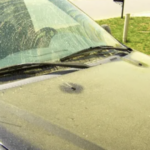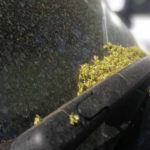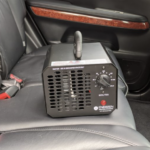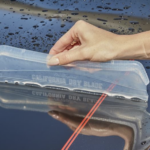How to Restore and Protect Faded Headlights for Better Visibility
Why Headlight Restoration is Important
Over time, headlights become cloudy, yellowed, or hazy, reducing their brightness and making nighttime driving more difficult. This happens because the clear protective layer on plastic headlight lenses breaks down due to UV exposure, oxidation, and road debris.
Faded headlights don’t just affect appearance—they pose a serious safety risk. Reduced light output makes it harder to see at night, during fog, or in bad weather. Restoring and protecting headlights improves visibility and ensures your car looks well-maintained.
Common Causes of Headlight Fading
UV Exposure
Sunlight is one of the biggest causes of headlight oxidation. The clear protective coating applied by manufacturers wears off over time, leaving the plastic exposed to UV rays. This leads to yellowing and cloudiness.
Oxidation
Oxidation occurs when oxygen reacts with the plastic, breaking it down. This process happens faster in hot, humid climates, making Florida’s weather particularly harsh on headlights.
Dirt, Road Debris, and Chemicals
Road salt, dirt, and small debris sandblast the surface of headlights, causing tiny scratches that make them look dull. Car wash chemicals and automatic brushes can also wear away protective coatings.
Moisture Buildup Inside the Headlight
Condensation inside the headlight lens makes it appear foggy. This usually happens due to a cracked seal or poor ventilation, allowing moisture to get trapped.
Signs Your Headlights Need Restoration
- Yellowing or cloudiness that won’t wash off.
- Dim or scattered light output when driving at night.
- Rough or chalky texture on the lens surface.
- Uneven lighting patterns or shadows on the road.
If headlights are severely faded, they may need polishing and sealing to restore clarity. In extreme cases, replacement is required.
Best Methods for Headlight Restoration
1. Cleaning the Headlights Before Restoration
Before starting any restoration process, headlights should be cleaned thoroughly to remove dirt and grime.
- Use a pH-balanced car shampoo or all-purpose cleaner.
- Scrub with a soft sponge or microfiber towel.
- Dry completely before moving to the next step.
2. Using a DIY Toothpaste Method for Light Haze
For minor oxidation, toothpaste works as a mild abrasive to polish out the haze.
- Apply a small amount of toothpaste (non-gel, whitening formulas work best).
- Use a microfiber cloth or soft brush to rub in circular motions.
- Rinse with clean water and dry completely.
This method is effective for mild cases but won’t remove deep oxidation or scratches.
3. Sanding and Polishing for Severe Oxidation
For headlights with heavy yellowing or scratches, sanding is the best option.
Materials Needed:
- Sandpaper (800, 1500, and 2000 grit)
- Spray bottle with water
- Plastic or headlight polish
- Microfiber towels
- UV-protective sealant
Step-by-Step Sanding Process:
- Mask Off Surrounding Areas – Use painter’s tape to protect the car’s paint.
- Wet Sanding with 800 Grit – Spray water on the headlight and sand in straight lines.
- Move to 1500 Grit – This smooths out the surface further.
- Finish with 2000 Grit – Removes any remaining roughness.
- Polish the Headlight – Use a plastic polish with a microfiber cloth or buffer.
- Apply a UV-Protective Sealant – Prevents future oxidation and extends clarity.
Headlight Restoration Kits vs. Professional Services
Headlight Restoration Kits
Many restoration kits include sanding pads, polish, and UV protectant. These are great for DIY maintenance, but results depend on the severity of oxidation and proper technique.
Pros:
- More affordable than professional services.
- Can be done at home with minimal tools.
- Immediate improvement in clarity.
Cons:
- Results may not last as long without UV protection.
- Requires physical effort and patience.
- Doesn’t always work on heavily oxidized headlights.
Professional Headlight Restoration
If headlights are severely clouded, professional detailing services provide better, longer-lasting results. They use machine polishing, advanced sealants, and even ceramic coatings to protect the plastic.
Pros:
- Higher-quality finish than DIY methods.
- UV-sealing technology extends the lifespan of clear headlights.
- Removes deep oxidation more effectively.
Cons:
- Costs more than DIY methods.
- Requires scheduling an appointment.
For vehicles in hot, sunny climates like Florida, professional services offer stronger protection against UV damage.
How to Protect Your Headlights After Restoration
Apply a UV-Protective Coating
After restoring clarity, applying a headlight sealant or ceramic coating prevents oxidation. These coatings block UV rays and keep the plastic from yellowing.
Park in the Shade or Use a Car Cover
Keeping the car out of direct sunlight slows down oxidation. Parking in garages, using sunshades, or applying headlight covers helps extend their lifespan.
Regularly Clean and Wax the Headlights
- Wash headlights weekly to prevent dirt buildup.
- Apply a spray wax or headlight sealant every few months for added protection.
- Avoid harsh chemicals, as they can degrade the plastic over time.
When to Replace Your Headlights Instead of Restoring
If headlights are cracked, have moisture trapped inside, or produce weak light output even after cleaning, replacement may be the better option.
- Condensation inside the lens indicates a broken seal.
- Flickering or dim bulbs may suggest an electrical issue.
- Deep cracks or internal discoloration can’t be fixed with restoration.
For older vehicles, replacing headlights with LED or HID options improves visibility and efficiency.
Final Thoughts
Faded headlights aren’t just a cosmetic issue—they directly impact nighttime visibility and driving safety. Regular maintenance, UV protection, and occasional restoration keep headlights in top condition.
Whether using DIY methods, restoration kits, or professional detailing, restoring clarity ensures safer driving and a well-maintained vehicle appearance.
Leave a Comment Cancel Comment
Book Orlando Mobile Detailing
Search
Latest Post
-
 The Cost of Neglect: Why Regular Aircraft Detailing Saves Money in the Long Run
February 14, 2025
The Cost of Neglect: Why Regular Aircraft Detailing Saves Money in the Long Run
February 14, 2025
-
 Why Car Washes Aren’t Enough to Combat Pollen Damage
February 13, 2025
Why Car Washes Aren’t Enough to Combat Pollen Damage
February 13, 2025
-
 Orlando’s Pollen Problem: When Is It the Worst and How It Affects Your Car
February 13, 2025
Orlando’s Pollen Problem: When Is It the Worst and How It Affects Your Car
February 13, 2025
-
 How Ozone Generators Eliminate Stubborn Car Odors in Orlando
February 12, 2025
How Ozone Generators Eliminate Stubborn Car Odors in Orlando
February 12, 2025
-
 Why a Water Blade and Chamois Beat Towels Every Time!
February 9, 2025
Why a Water Blade and Chamois Beat Towels Every Time!
February 9, 2025
